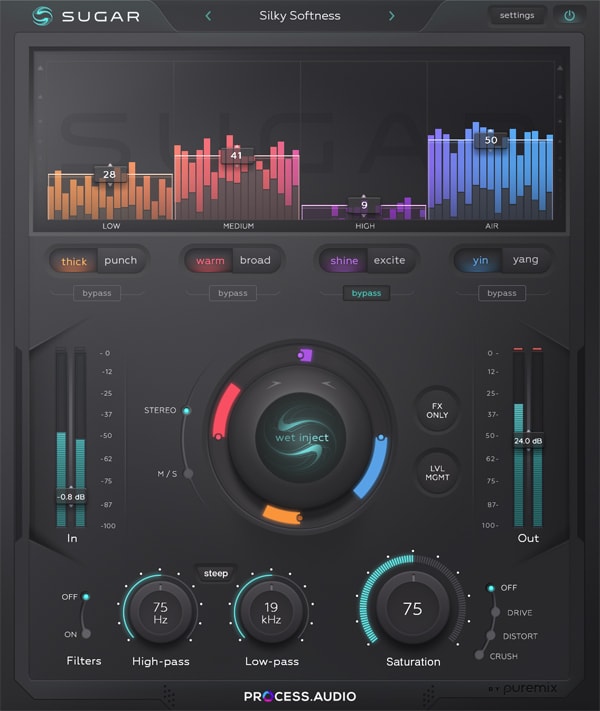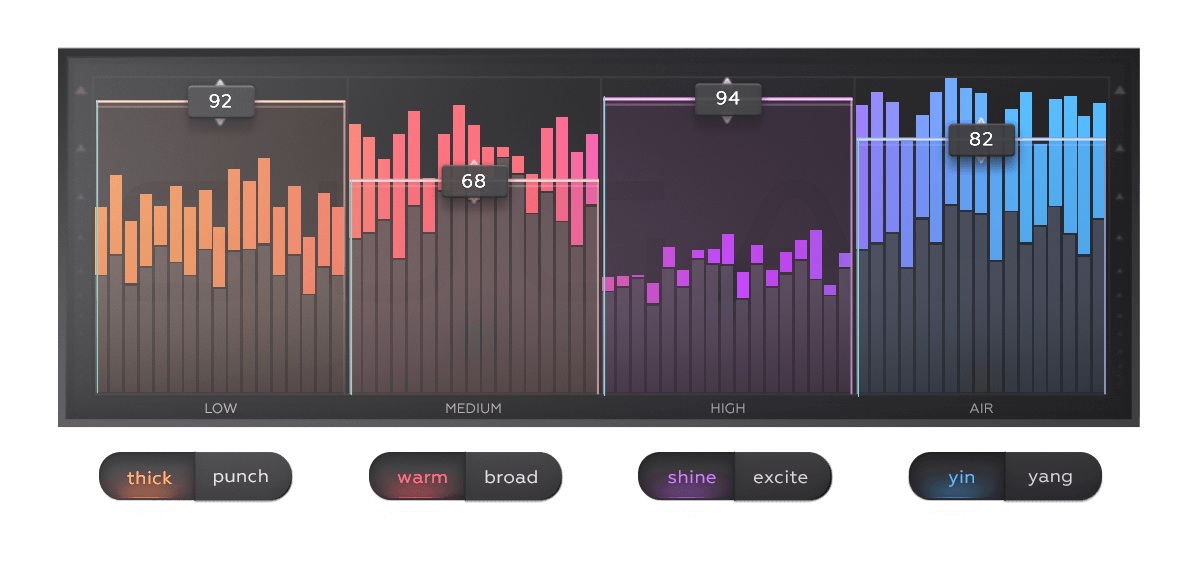New Software Review: Sugar by Process.Audio

Process.Audio makes their debut with Sugar, a one-stop shop built to give your tracks that extra bit of sweetness.
Sugar is an all-new harmonic exciter plugin that’s been called “the ultimate audio sweetener.” Released in March of 2019, Sugar is the first plugin from Process.Audio, a company founded by the folks at pureMix. As such, Sugar is available for free with all pureMix Pro Memberships, and can be purchased separately for $149.
In just a handful of short months, Sugar has earned the praise of several award-winning engineers, including Greg Wells, Darrell Thorp, Vance Powell, and more. With four bands of harmonics processing, selectable saturation types, variable filters, and an intuitive interface, Sugar makes it easy to achieve sounds that would typically require multiple high-end analog signal processors.
Read on to see if Sugar lives up to the hype!
Features
Open Sugar and you’re greeted by a sleek black interface that should instantly feel familiar to those who have used multi-band harmonics processors before. Monitor the frequency response of the incoming signal using the brightly colored multi-band bar graph.
Sweetening tracks with Sugar is fast and intuitive—simply raise one of the four bands labeled “Low,” “Medium,” “High,” and “Air” to increase the harmonic processing. Sugar features limited controls for a streamlined workflow; each of the four frequency bands offers two fixed positions designed to target frequencies that commonly cause mix issues.
Choose from “Thick” or “Punch” on the low band, “Warm” or “Broad” on the mid band, “Shine” or “Excite” on the high band, and “Yin” or “Yang” on the air band. The manual suggests that trying both the Yin and Yang settings every time you use the band to help avoid phase problems in the highly-sensitive air frequency range. Each band also features a bypass setting for quickly A/B-ing.
In addition to input level controls on the left and output level controls on the right, you can adjust all four harmonics processing faders at once using the big bright knob in the center of the interface. Simply turn the jog wheel to the right to increase processing levels, and to the left to decrease them.

Sugar’s streamlined interface allows for quick and effective tweaks—and you won’t get bogged down in the minutia along the way.
On the left side of the jog wheel, there are controls for Stereo and Mid/Side mode. On the right side, you’ll find the “FX ONLY” button, which lets you monitor the wet signal and hear exactly what you’re adding to the mix. Use the “LVL MGMT” button to automatically adjust the output level based on the amount of processing you apply to prevent peaking.
At the bottom of Sugar’s interface, you’ll find additional controls for fine-tuning your tone. On the left, there are two linear phase filters for rolling off the highs and lows. On the right, you can control the amount and type of saturation—choose Drive to add a little crunch, Distort for aggressive-sounding distortion, and Crush to totally obliterate your signal.
In Use
In order to test all of Sugar’s features, I tried using it on drums, bass, guitar, synthesizer, and the mix bus.
On the drums, I actually used two instances of Sugar. In order to familiarize myself with the controls, I started flipping through presets. When I landed on “Cymbal Electro MS Drama” I immediately noticed a huge difference in the stereo width of the drum kit. By utilizing Mid-Side mode and boosting the Excite band on the sides, Sugar was able to totally rearrange the position of the hi-hat in the mix. For tone, I loaded a second instance of Sugar in Stereo mode and increased the Warm and Excite bands. I also added a healthy dose of saturation in Distort mode.
On the bass guitar, I used the low band on Punch, the mid band on Warmth, and the High band on Excite to bring out the sound of the pick. I turned the Saturation knob up about halfway on Drive mode to add a little grit and help the bass cut through the mix.
After pushing Sugar pretty hard, I wanted to see how it sounded at lower settings, so for the guitar I simply added a touch of highs on Excite, and a little bit of saturation on Drive.
Similarly, on the synths I used the mid band on Broad and the high band on Shine to help add color and character without competing with the guitars or cymbals.
On the mix bus I tried putting the Mid-Side mode to the test with plenty of lows in the center, plenty of air on the sides, and some well-placed high-pass and low-pass filtering.
Click here to download the full resolution audio files.
To Be Critical
Overall, I was really pleased with Sugar, so to critique anything would be a stretch. It offers you a quick and easy way to sweeten individual tracks or busses with professional-sounding results. It may not offer total customization of every parameter, but that’s kind of the point. Sugar is designed to make your tracks sound better with minimal effort, so it would be unfair to fault it for its lack of highly-detailed control.
The pre-selected frequencies for each band are well-chosen and were useful in most situations. The jog wheel in the center makes it easy to dial in the perfect amount of processing, and offers some interesting automation options. I also really enjoyed being able to separately control the amount and type of saturation, although I did find myself wishing I could choose different options for each band.
Summing it Up
The real draw of Sugar is its fast, intuitive workflow. It’s a great go-to plugin for when a track needs that little something extra and you don’t want to waste too much time setting up an elaborate signal chain.
If you’re a pureMix member, this one is a no-brainer… go download Sugar right now. It’s an excellent plugin to add to your collection. But, if you’re an old pro, you probably already have a processor that can achieve similar results. And if you’re just starting out, the $149 price tag may be too steep for a plugin with such limited features. However, if you’re a student or teacher, Process.Audio offers an educational discount that significantly reduces the price.
And if you’re still on the fence about Sugar, try it free for 30 days.
Brad Pack is an award-winning audio engineer and writer based in Chicago, IL. He currently owns and operates Punchy Kick, a professional mixing and mastering studio that specializes in pop punk, emo, punk, grunge, and alternative music.
He has been helping artists connect with fans through emotionally resonant mixes, cohesive masters, and insightful guidance for over 10 years. Check out his website PunchyKick.com or say hi on Instagram @PunchyKick.
Please note: When you buy products through links on this page, we may earn an affiliate commission.







[…] Sugar is an all-new harmonic exciter plugin that’s been called “the ultimate audio sweetener.” Released in March of 2019, Sugar is the first plugin from Process.Audio, a company founded by the folks at pureMix. As such, Sugar is available for free with all pureMix Pro Memberships, and can be purchased Read more… […]